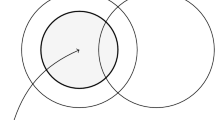In this paper, the meanings of sentences containing the word or and a modal verb are used to arrive at a novel account of the meaning of or coordinations. It is proposed that or coordinations denote sets whose members are the denotations of the disjuncts; and that the truth conditions of sentences containing or coordinations require the existence of some set made available by the semantic environment which can be ‘divided up’ in accordance with the disjuncts. The relevant notion of ‘dividing things up’ is made explicit in the paper. Detailed attention is given to the question of how the proposed truth conditions are derived from the syntactic input. The account offered allows for the derivation of both the disjunctive and the non-disjunctive readings of modal/or sentences, including the much-discussed ‘free choice’ readings of may/or sentences.
Similar content being viewed by others
References
Aloni, M.: (2002), ‘Free Choice in Modal Contexts’, in M. Weisgerber (ed.), Arbeitspapier Nr. 114 des Fachbereichs Sprachwissenschaft, University of Konstanz. [Available at http://www.xs4all.nl/wander/aloni/]
Condoravdi, C.: (2001), ‘Temporal Interpretation of Modals’, in Stanford Papers on Semantics, CSLI Publications, Stanford. [Available at http://semanticsarchive.net/]
P. Geach (1973) ArticleTitle‘A Program for Syntax’ Synthese 22 483–497
Geurts, B.: 2004, ‘Entertaining Alternatives: Disjunctions as Modals’, unpublished ms., University of Nijmegen.
Groenendijk, J. and M. Stokhof: 1984, Studies on the Semantics of Questions and the Pragmatics of Answers, PhD dissertation, University of Amsterdam.
C. L. Hamblin (1973) ArticleTitle‘Questions in Montague English’ Foundations of Language 10 41–53
Johnson, K.: 1996 ‘Bridging the Gap’, chapter in In Search of the English Middle Field, unpublished ms., University of Massachusetts, Amherst.
H. Kamp (1973) ArticleTitle‘Free Choice Permission’ Proceedings of the Aristotelian Society 74 57–74
A. Kratzer (1977) ArticleTitleWhat Must and Can Must and Can Mean’ Linguistics and Philosophy 1 337–355
Kratzer, A.: 1981 ‘The Notional Category of Modality’, in H. Eikmeyer and H. Rieser (eds.), Words, Worlds and Contexts, pp. 38–74. De Gruyter, Berlin.
A. Kratzer (1991) ‘Modality’ A. von Stechow D. Wunderlich (Eds) Semantik/Semantics: An International Handbook of Contemporary Research De Gruyter Berlin 639–650
Kratzer, A. and J. Shimoyama: 2002, ‘Indeterminate Pronouns: The View from Japanese’, Proceedings of the Third Tokyo Conference on Psycholinguistics, pp.1--25. [Longer version available at http://semanticsarchive.net/]
R. Larson (1985) ArticleTitle‘On the Syntax of Disjunction Scope’ Natural Language and Linguistic Theory 3 217–264
D. Lewis (1973) Counterfactuals Blackwell Oxford
D. Lewis (1981) ArticleTitle‘Ordering Semantics and Premise Semantics for Counterfactuals’ Jounal of Philosophical Logic 10 217–234
Munn, A.: 1993, Topics in the Syntax and Semantics of Coordinate Structures, PhD dissertation, University of Maryland, College Park.
M. Rooth B. H. Partee (1982) ‘Conjunction, Type Ambiguity and Wide Scope Or’ D. Flickinger M. Macken N. Wiegand (Eds) Proceedings of the First West Coast Conference on Formal Linguistics Stanford Linguistics Association Stanford 1–10
B. Partee M. Rooth (1983) ‘Generalized Conjunction and Type Ambiguity’ R. Bäuerle C. Schwarze A. Stechow Particlevan (Eds) Meaning, Use and Interpretation of Language De Gruyter Berlin 361–383
W.Orman Quine Particlevan (1967) The Ways of Paradox. Harvard University Press Cambridge, Mass
M. Rooth (1985) Association with Focus, PhD dissertation GLSA, University of Massachusetts Amherst
B. Schwarz (1999) ArticleTitle‘On the Syntax of Either⋖Or’ Natural Language and Linguistic Theory 17 339–370
M. Siegel (1984) ArticleTitle‘Gapping and Interpretation’ Linguistic Inquiry 15 523–530
Simons, M.: 1998, Issues in the Semantics and Pragmatics of Disjunction, PhD dissertation, Cornell University. [Published by Garland, NewYork, 2000.]
R. Stalnaker (1975) ArticleTitle‘Indicative Conditionals’ Philosophia 5 IssueID3 269–286
R. Stockwell P. Schachter B. H. Partee (1973) The Major Syntactic Structures of English. Holt Rinehart and Winston New York
T. Werner (2003) Deducing the Future and Distinguishing the Past: Temporal Interpretation in Modal Sentences in English PhD dissertation Rutgers University
Y. Winter (1995) ‘Syncategorematic Conjunction and Structured Meanings’ Proceedings of Semantics and Linguistic Theory 5. CLC Publications Cornell University, Ithaca, N.Y
Y. Winter (2000) On Some Scopal Assymetries of Coordination H. Bennis (Eds) et al. Interface Strategies KNAW Amsterdam
T. E. Zimmermann (2000) ArticleTitle‘Free Choice Disjunction and Epistemic Possibility’ Natural Language Semantics 8 IssueID4 255–290
Author information
Authors and Affiliations
Corresponding author
Additional information
Thanks to the various people whose comments on earlier versions contributed to the development of this paper: Sally McConnell-Ginet, Graeme Forbes, members of the Philadelphia Semantics Circle, and two anonymous reviewers for this journal.
Rights and permissions
About this article
Cite this article
Simons, M. Dividing things up: The semantics of or and the modal/or interaction. Nat Lang Seman 13, 271–316 (2005). https://doi.org/10.1007/s11050-004-2900-7
Issue Date:
DOI: https://doi.org/10.1007/s11050-004-2900-7




